
Lakeshore East is a master-planned mixed use urban development being built by the Magellan Development Group in the Loop community area of Chicago in Cook County, Illinois, United States. It is located in the northeastern part of the Loop, which, along with Illinois Center, is called the New Eastside. The development is bordered by Wacker Drive to the north, Columbus Drive to the west, Lake Shore Drive to the east, and East Randolph Street to the south. Skidmore, Owings & Merrill created the master plan for the area. The development, which had been scheduled for completion in 2011, was set for completion in 2013 by 2008. Development continued with revised plans for more buildings in 2018 and continuing construction of the Vista Tower in 2019.
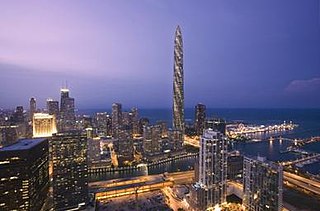
The Chicago Spire was a skyscraper project in Chicago that was partially built between 2007 and 2008 before being cancelled. Located at 400 N. Lake Shore Drive, it would have stood 2,000 feet (610 m) high with 150 floors and been the tallest building in the Western Hemisphere. When originally proposed as the Fordham Spire in July 2005, the design had 116 stories, included a hotel and condominiums, and was topped with a broadcast antenna mast. The building was designed and spearheaded by Spanish architect-engineer Santiago Calatrava and Chicago developer Christopher T. Carley of the Fordham Company. On March 16, 2006, the Chicago Plan Commission unanimously approved the initial design of the building. On November 4, 2016, a court ruling brought the original development plan and the extended litigation over the nine-year-old project to a close. Developer Garrett Kelleher signed over the property location to the project's biggest creditor, Related Midwest, who announced that they would not build the Spire and released plans for a different project.
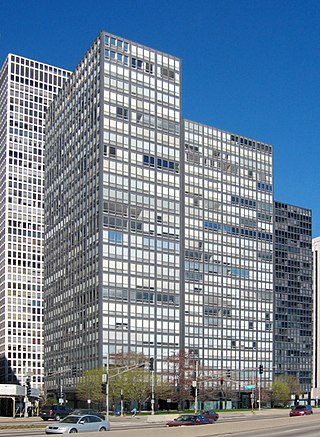
860–880 Lake Shore Drive is a twin pair of glass-and-steel apartment towers on N. Lake Shore Drive along Lake Michigan in the Streeterville neighborhood of Chicago, Illinois. Construction began in 1949 and the project was completed in 1951. The towers were added to the National Register of Historic Places on August 28, 1980, and were designated as Chicago Landmarks on June 10, 1996. The 26-floor, 254-ft tall towers were designed by the architect Ludwig Mies van der Rohe, and dubbed the "Glass House" apartments. Construction was by the Chicago real estate developer Herbert Greenwald, and the Sumner S. Sollitt Company. The design principles were copied extensively and are now considered characteristic of the modern International Style as well as essential for the development of modern high-tech architecture.
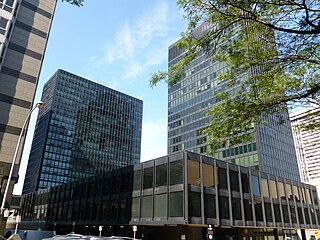
Westmount Square is a residential and office complex located in Westmount, Quebec, Canada. There are two residential apartment buildings and two office buildings. These towers sit atop an underground shopping centre consisting of thirty-five shops. It is located between Saint Catherine Street and De Maisonneuve Boulevard and between Wood Avenue and Greene Avenue. It is connected to Place Alexis Nihon, Dawson College, and the Atwater Metro station by a tunnel.

OneEleven is a luxury rental apartment tower located in downtown Chicago, Illinois. The building is located between LaSalle Street and Clark Street, adjacent to River North and directly on the Chicago River.

The Heritage at Millennium Park, located at 130 N. Garland Court in Chicago, Illinois is a mixed-use tower. Completed in 2005, with a height of 631 feet (192 m) and 57 floors, the building was designed by the architectural firm Solomon Cordwell Buenz. It is the 36th-tallest building in Chicago. Like many newer buildings, the Heritage preserves and makes use of the façades of four existing buildings in its base.

55 East Erie is an all-residential skyscraper in Chicago. It is at 647 feet (197 m). Designed by Fujikawa Johnson & Associates and Searl & Associates Architects, the 56 story building was completed in 2004 and is the fourth-tallest all-residential building in the United States after Trump World Tower in New York City, One Museum Park in Chicago, and the nearby 340 on the Park completed in 2007 in Chicago.

One Museum Park is a skyscraper in Chicago, United States. It was designed by Chicago-based architecture firm Pappageorge Haymes, Ltd. and is located in the Near South Side community area.
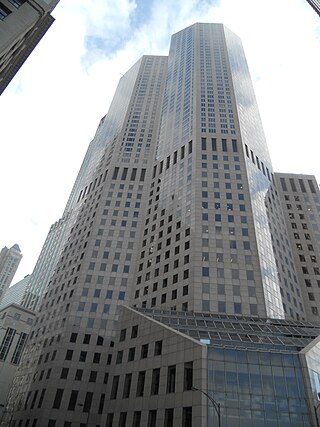
One Magnificent Mile is a mixed-use high-rise tower completed in 1983 at the northern end of Michigan Avenue on the Magnificent Mile in Chicago containing upscale retailers on the ground floor, followed by office space above that and luxury condominium apartments on top. The 57-storey building was designed by Skidmore, Owings & Merrill and at the time of construction was the tenth-tallest building in Chicago.
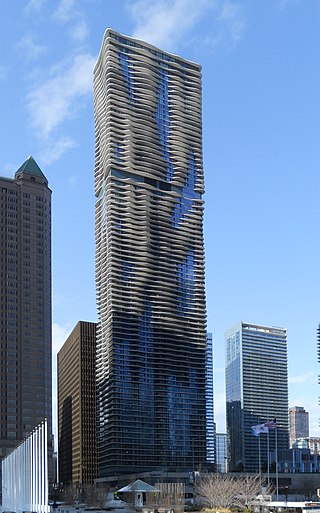
Aqua is an 82-story mixed-use skyscraper in Lakeshore East, downtown Chicago, Illinois. Designed by a team led by Jeanne Gang of Studio Gang Architects, with James Loewenberg of Loewenberg & Associates as the Architect of Record, it includes five levels of parking below ground. The building's eighty-story, 140,000 sq ft (13,000 m2) base is topped by a 82,550 sq ft (7,669 m2) terrace with gardens, gazebos, pools, hot tubs, a walking/running track and a fire pit. Each floor covers approximately 16,000 sq ft (1,500 m2).
The Villa Magna Condominium Complex was an urban development that was planned to rise on a 2.5-acre (1.0-hectare) plot in Brickell, downtown Miami, Florida. It was approved in 2006 by the city council and the Federal Aviation Administration and construction was slated to begin in April 2007. The ending date was approximated to be late 2008 or early 2009; however, the housing crisis of the late 2000s halted the project. The project was revived as The Towers by Foster + Partners in 2016, after FAA approval of supertall heights. Done in the early 2020s the site was sold again to Citadel Group who planned a move to Miami from Chicago.

The Legacy at Millennium Park is a 72-story skyscraper in Chicago, Illinois, United States, located along S. Wabash Avenue, near E. Monroe Street. At 822 feet, it is the seventeenth-tallest building in Chicago.
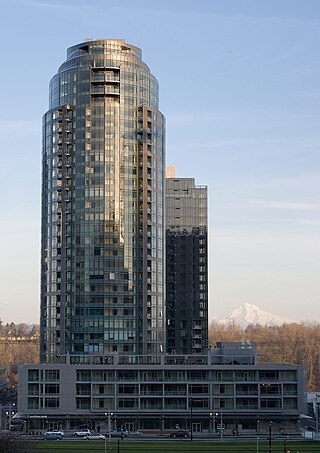
John Ross Tower is a condominium skyscraper in the South Waterfront neighborhood in Portland, Oregon. It stands at a height of 99.1 m (325 ft), the first building in the district to reach the maximum height allowed for development and Portland's seventh-tallest building. It is also the largest residential building built in Portland since the KOIN Center in 1984. It was designed by the firm of TVA Architects and topped out in 2007. The Oregonian called it the "symbol of condo craze" in Portland, with sales opening "at the height of the condo bubble" in 2005.

The Palace Pier is the site of Palace Place and Palace Pier, two cruciform condominium towers tied for the 45th-tallest building in Toronto, Ontario, Canada. They are located at 2045 Lake Shore Boulevard West and 1 Palace Pier Court in the Humber Bay neighbourhood in the former city of Etobicoke.

North Pier Apartments is a 581 ft (177m) tall skyscraper in Chicago, Illinois. It was completed in 1990 and has 61 floors. Dubin Dubin Black and Moutoussamy designed the building, which is the 43rd tallest and the tallest precast concrete panel clad building when completed, in Chicago. The buildings façade has dark gray, maroon, and pink panels in an abstract pattern. It was named after North Pier, a long building to the west along Ogden Slip. It has been described by the architects to be masculine counterpart to the curvaceous Lake Point Tower nearby.

235 Van Buren is a high-rise condominium building located in Chicago's Loop neighborhood near the Willis Tower and the 311 South Wacker Drive Building. The 46 story skyscraper was designed by Perkins & Will and built by CMK Companies, a Chicago-based real estate development company. As the building's name suggests, it is located at 235 West Van Buren Street adjacent to the Chicago River at the eastern terminus of Eisenhower Expressway.
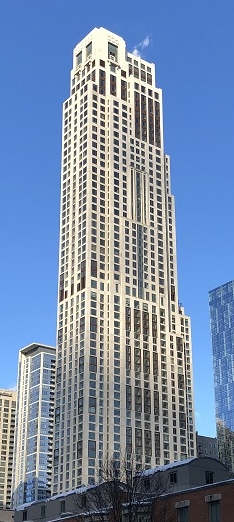
One Bennett Park is a skyscraper at 451 East Grand Avenue, in the Streeterville neighborhood of Chicago. The project was first announced as the building at 451 E. Grand Ave. in July 2014, approved in December 2014, and named One Bennett Park in October 2015. The building is named for Edward H. Bennett, the Chicago architect and urban planner who coauthored the 1909 Plan of Chicago. The building topped-out in late 2018, and later opened in the spring of 2019. It is among Chicago's tallest skyscrapers.






















